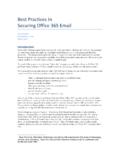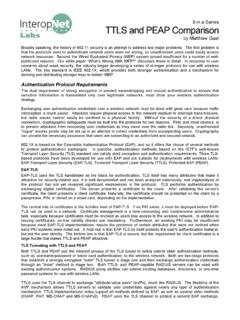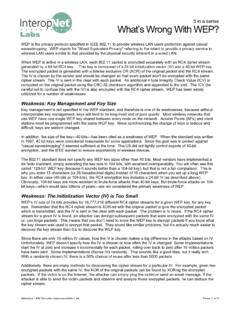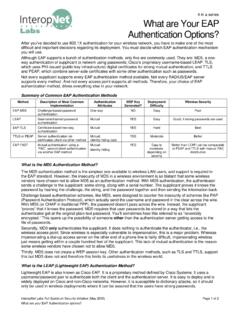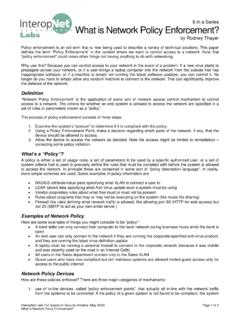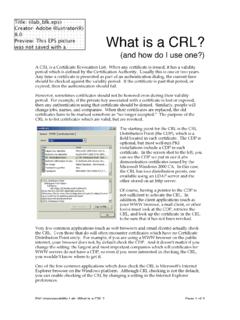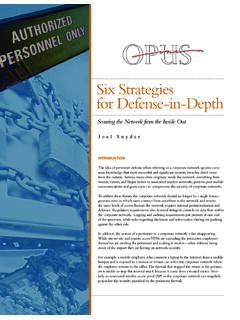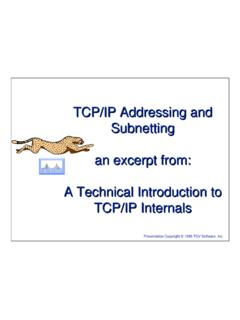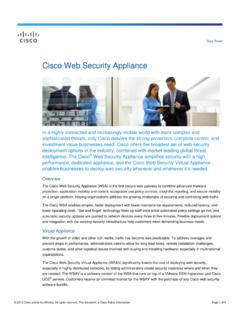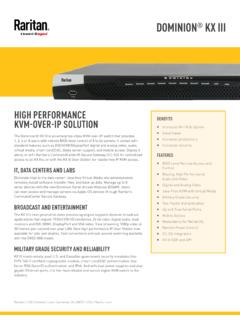Transcription of Firewalls in the Data Center: Main Strategies and …
1 Firewalls in the data center : main Strategies and MetricsJoel Snyder, PhDSenior Partner, Opus OneWhat You Will LearnMeasuring performance in networks has usually involved looking at one number: throughput. Since the first days ofswitches and routers, organizations have added up the performance they need, compared it to a total on amanufacturer s data sheet, and used those values to decide whether or not they had the right network managers have added Firewalls to improve the security of the data center , the same performanceengineering spotlight that shines on routers and switches is being applied to security appliances. When speedsjump above 10 Gbps as these Firewalls move closer to the core of the data center , reliable performance metrics arecritical. Unfortunately for security and network practitioners, the same basic metric of throughput cannot be used toevaluate firewall performance. Because a security appliance actively participates in connections from Layer 2 up toLayer 7, you cannot simply look at bits-per-second throughput to predict how a firewall will behave in the datacenter.
2 In this document, you will learn key metrics you should use to evaluate firewall performance in the data center andwhy raw throughput is almost never the most important performance metric to use in your planning. Selecting afirewall does not mean simply picking the fastest firewall, but the one that is designed to handle the rapidly evolving,network-intensive application environment of the data center . You will also learn why today s Firewalls must be builtfrom the start to support today s network-based applications, and how to confidently use Firewalls to increasesecurity in data Firewall PerformanceBecause organizations always start with feeds andspeeds (how many ports and how fast do they go)when evaluating switches and routers, it is temptingto apply these same metrics to Firewalls : how manybits per second (bps) or packets per second (pps)can the device handle? If the firewall will go in thenetwork core, it seems logical to use the sameperformance metrics for a security device that youuse for a network example, stateless UDP traffic (such as youwould see in a Network File System (NFS)) andlong-lived TCP connections (such as you would see in a Microsoft Windows file system, an iSCSI Storage AreaNetwork (SAN), or a backup application) are common in many data center networks.
3 These types of applicationspresent continued and heavy load to the network. When you send file system traffic through a data center firewall, bits-per-second performance measurements areyour starting point. But even in these simple cases, other performance metrics are equally important. For example,latency is a critical concern, because if the firewall introduces delays, applications will be affected. Because of thenature of TCP and file system protocols, even a small increase in latency can cause dramatic MultiScale performance is acombination of breadth and depth. Itprovides rapid connections per second, anabundance of concurrent sessions, andaccelerated throughput. It also enablesmultiple security services and spansphysical, switch, and virtual platforms forexceptional flexibility. Fred Kost, Cisco SystemsUnfortunately, performance engineering gets more complex as your application mix goes beyond pure file systemprotocols.
4 After all, the network services that organizations are most interested in securing are application-layerprotocols. This is where the problem occurs, because when a firewall is securing complex application traffic, youcannot measure performance in just bits-per-second and milliseconds of and routers are active participants in the traffic that flows through them, but only up to Layer 3, the IPlayer. Firewalls , however, are aware of each TCP connection and UDP session that passes through them. Theyparticipate at Layer 4, the session layer, at a minimum. As application connections come and go, the firewall mustalso create and tear down its own internal data structures to maintain state information for every session. This stateinformation is checked and updated for every packet that passes through the firewall to provide the highest level ofprotection against sophisticated attacks. When the firewall is also providing Network Address Translation (NAT) services or running Application LayerGateways (ALGs) for applications such as voice over IP (VoIP) or video conferencing, the load rises even higherbecause the firewall has to decode and manage traffic all the way up to Layer 7, the application layer.
5 Movingfurther and further up the stack makes network engineering more difficult and performance measurement the data center , application traffic puts a very different load on the network than file system traffic. Client-servercommunications between users and servers, and server-server communications between application, database,and directory servers have very different profiles. Application traffic is connection intensive, with connectionsconstantly being set up and torn down. This connection intensity adds another dimension to performanceengineering. You must look beyond pure IP throughput and latency and include connection rates and a user logs in and connects to a file server, a TCP connection is created that can stay alive for hours. A half-second of delay in connection establishment will not even be noticed. But if the same user runs an application thatopens two dozen connections for every page displayed, and each connection takes 500 extra milliseconds to set upbecause a firewall is adding delay, productivity will be affected.
6 The evolution of modern applications is tipping the balance from pure performance measures to metrics such asconnection rate and concurrent-connection capacity. For example, look at the Cisco website. In the past 15 years,while the size of the homepage has increased by 30 percent, the number of end-user connections required todownload the page has tripled. Further, this value refers just to the page that appears to greet visitors. Logged-inusers present an even heavier load as cookies are checked and the page is dynamically updated (Figure 1).These statistics show only the front end of the application. Consider that for every page displayed, the front-endweb server may also be querying for directory information, including subscription and entitlement information,checking security permissions, updating back-end state information and setting cookies, tracking user preferences82326165K232K274538 Number ofConnectionsNumber ofHostsKilobytesTransferredPacketsTransf erred19962010 The size of the web page increased by 30 percent over 15 years, but the number ofnetwork connections required tripledFigure 2and history, and consulting content-distribution networks to modify the page in real time.
7 A single click on a webapplication can cascade into a plethora of transactions across an entire data center . The growth of the Internet represents one type of surge in use. A similar surge is also occurring inside the firewall,brought about by the increase in connected personal devices. The employee who previously had only a standarddesktop computer may now also have a smartphone and a netbook or tablet device, all wireless, silently connectingto applications and services even when inside a pocket. One employee may now be putting two or three times theload on the network than that employee did before mobility became pervasive. As applications and use patterns change, Firewalls must change. The issue, however, is not just raw performance:today s firewall should not be just a faster version of yesterday s firewall. The firewall has to be reengineered tosecure a different type of traffic with different performance Firewall PerformanceAs the network threat landscape has evolved, attacks have moved up the stack and focused on applications,usually web-based ones.
8 Old threats with cute names like Smurf and Ping of Death are not significant anymore,as attackers have gone after the weakest link: the application. The capability to counter these advanced attacks hascome to define the next generation of Firewalls : security devices that are application aware and provide advancedintrusion-prevention capabilities (Table 1).Measuring the performance of next-generation Firewalls is difficult because the performance of these Firewalls isnow data dependent. Traditional Firewalls required aclose analysis of connection rates and connectioncapacities. Next-generation Firewalls applying next-generation protections, such as application awarenessand intrusion prevention, will offer different levels ofperformance depending on the data flowing throughthem. Unfortunately, as Firewalls add increasinglysophisticated threat protections, the data dependenceperformance problem gets worse, not , the measure of firewall performance has to go beyond Layer 4 metrics , such as connections per second ormaximum number of simultaneous connections, and include Layer 7 measures, such as transactions per example, if the firewall is HTTP aware, as most Firewalls are, then HTTP transaction performance can be animportant bottleneck.
9 Because each transaction may contain different data and may activate different applicationprotections, each transaction presents a different processing load to the firewall. In other words, two HTTP transactions of identical size may have different performance characteristics due to the data within the transaction. In the quest to write the most interesting and engaging applications, developers have paid little attention to networkperformance and focused instead on usability. The result for firewall managers is an enormous amount ofApplication-Aware Next-Generation Firewalls Must Handle The surge of connections when a user first opens the application webpageMaintain Connections as long as the user is within the application, even if no traffic is being transferredAnalyze The content of each application object, looking for prohibited content and potential network threatsSupport IP throughput and latency requirements of the application to maintain user productivity and comply withinternal service-level agreements (SLAs)Application-Aware Firewalls must apply a complex set of security controls withoutaffecting end-user perception of performanceTable up the stack to secure theapplication layer makes performancemeasurement difficult and 3uncertainty, as apparently simple applications begin to crush security appliances with the heavy load they put on thenetwork.
10 Old rules of thumb, such as the assumption that web pages will open and close connections quickly, justdo not apply any one popular Internet application: Facebook itself is not a corporate application,it represents a class of web-based applications that arealready inspiring enterprise application center managers hoping to secure applicationservers should consider Facebook as a things tocome example of what they will soon be dealing withinside the corporate time a Facebook user decides to check their homepage, the web browser opens multiple connections tomultiple hosts; most of those connections download multiple objects, each of which must be individually analyzedby a next-generation firewall. One test found 19 connections opened to seven different hosts, downloading morethan 50 HTTP objects, in less than five seconds. While a traditional firewall would be stressed by so manyconnections, a next-generation firewall is stressed even further by the large number of objects on every singlepage.
